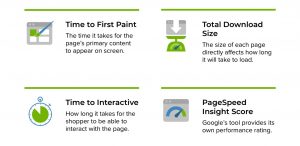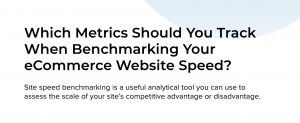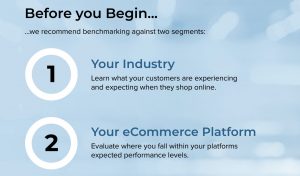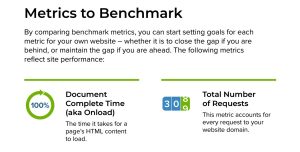
Running a Competitive Website Performance Benchmark
A guide to benchmarking your website against competitor sites
A “benchmark” is a starting point you can use to know if your business efforts are working or not. You can also use benchmarks to set those business goals in the first place. For example, benchmarking website performance metrics using your competition will give you a good idea where to get started — and what numbers to beat.
Want a better look into your site’s performance? Get a free eCommerce Snapshot Report for your site today!
Why benchmark?
Let’s use site speed as an example. A fast performing website provides a competitive advantage in many ways. Site speed benchmarking is a useful analytical tool you can use to:
- Assess the scale of your site’s advantage or disadvantage
- Set reasonable expectations for your stakeholders
- Gain context for interpreting results from tools such as Google’s PageSpeed Insights
- Prioritize areas of the site for improvement
We recommend benchmarking against two segments. The first is within your industry — with your direct competitors who are vying for your customers — in order to see what your customers are experiencing and expecting. The second is within your eCommerce platform, such as Salesforce Commerce Cloud or Shopify, in order to evaluate where your site’s performance falls within your platform’s expected performance levels.
How to benchmark website performance against competitors
Below we describe best practices for benchmarking against competitor sites:
- Identify competitor sites. Review the list of top internet retailers and note 5-10 within your industry who likely share your target customer base. The competitor sites should have similar merchandising needs, product catalog sizes, and product variation complexity.
- For each site you analyze, including your own, take note of specific URLs for the most common page types (typically Homepage, Category Page, and Product Pages). These are the page types you will be comparing across sites. Note if the URLs are different across Desktop and Mobile.
- For benchmarking tools, we recommend using webpagetest.org which allows for real device testing. This allows you to specify and standardize the settings for each test. We recommend using the settings below, but you may need to adjust based on your target audience demographics:
| Desktop: | Mobile: |
| Location: EC2 Virginia | Location: EC2 Virginia |
| Browser: Chrome | Device: IPhone X |
| Speed: Cable | Speed: 4G |
| Number of samples: 2 minimum | Number of samples: 2 minimum |
| Capture Video enabled | Capture Video enabled |
Pro Tip: With webpagetest.org, your test results are captured by the URL that is created when you begin the test. While the test is queued, you can copy/paste the URL into a separate document and then return to it later once the test has completed. This is especially helpful when you are behind 20 other IPhone X tests!
Another common benchmarking tool is Google’s PageSpeed Insights. We find it useful to run competitive benchmarks in order to gain context to interpret your site’s results. Spoiler alert: the majority of eCommerce sites score very low on PageSpeed Insights, particularly on mobile:

Assessing eCommerce platform benchmarks
In addition to benchmarking your competitors, we highly recommend checking your site’s performance against other sites that utilize your current eCommerce platform. This provides another context for interpreting your site’s speed and setting goals. For example, at YOTTAA we see that Salesforce Commerce Cloud sites can run faster than Shopify sites.
While you are doing the competitor benchmarking, you can use a tool such as builtwith.com to see what eCommerce platform other sites are using. Alternatively, you can ask your eCommerce platform for other example customer sites.
At YOTTAA, we capture the minimum, maximum, and average site speeds across all eCommerce platforms. If you are a YOTTAA customer, you can access this information within Yottaa’s Rapid Dashboard under the Community tab and see how your site compares.
How often to run a website performance benchmark?
Ecommerce sites are constantly changing and improving, and since one 3rd party can add 500ms of page load time, it is critical to regularly monitor your site speed and benchmark. On a practical level, we recommend benchmarking quarterly ideally, and annual at minimum. This will ensure you are staying informed on industry shifts.
Want a better look into your site’s performance? Get a free eCommerce Snapshot Report for your site today!




